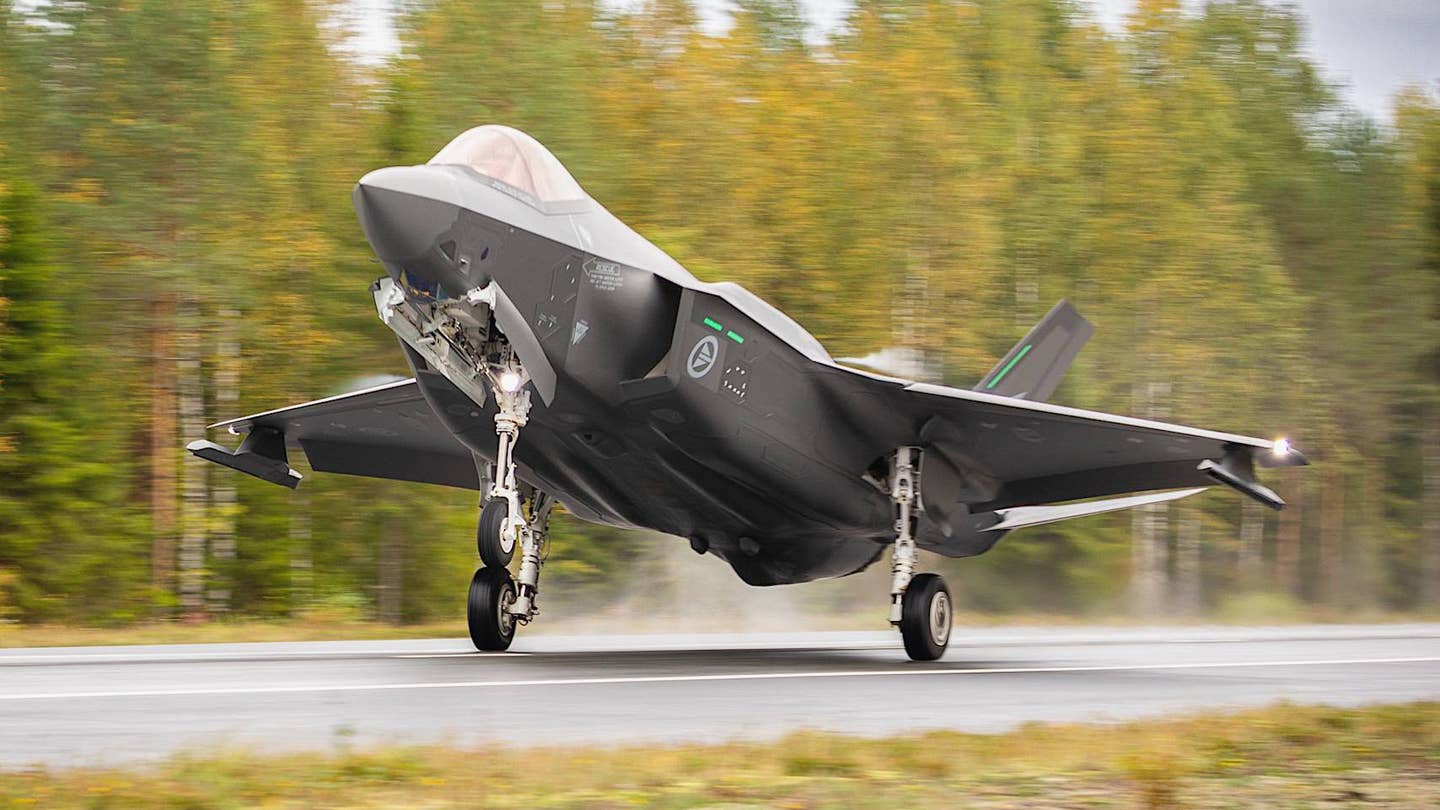Norway’s F-35As have shown the type can use roads as runways to reduce their vulnerability to enemy strikes during a Finnish exercise.

Suitable roadways offer air forces valuable alternative operating locations in the event their main bases are struck or otherwise rendered unusable and a way to readily disperse aircraft to help reduce their vulnerability. The tactic is also valuable when to comes to complicating the enemy’s targeting cycles and war planning.
Norwegian F-35s taxi on a road in Finland. Finnish Defense Forces
“This is a milestone, not only for the Norwegian Air Force, but also for the Nordic countries and for NATO,” Major General Rolf Folland, Chief of the Royal Norwegian Air Force, said in a press release today. “This demonstrates our ability to execute a concept of dispersal. Fighter jets are vulnerable on the ground, so by being able to use small airfields – and now motorways – [we can] increase our survivability in war.”
A Norwegian F-35A comes in to land on a highway in Finland. Finnish Air Force
Norweigan F-35As have been training to conduct highway operations in Finland this week as part of the latest iteration of that country’s annual Baana road base exercise, which kicked off on Monday. The jets were also “hot pit” refueled as part of the training, which means their engines remained running while they had fuel uploaded. This reduces the time required to get them back up in the air afterward and can further reduce vulnerability, as well as increase sortie rates during surges in operations. Sometimes crew changes can also occur. Just shutting down complex fighter aircraft can increase the chances that they will have serviceability issues starting up again.
Finnish personnel hotpit refuel a Norwegian F-35A during Baana 23. Finnish Defense Forces
For Baana 23, a section of Finland’s Regional Road 551 between the towns of Karttula and Tervo in the southern end of the country has been turned into an impromptu air base.
An annotated satellite image showing the stretch of Regional Road 551 in Finland where Baana 23 is taking place. Google Earth
“The Air Force trains regularly operations from other than a home base to be capable of a quick dispersal across the country, when necessary,” a press release about the exercise from the Finnish Defence Forces said. “Operation at road bases is part of the training of all Air Force pilots.”
From the pictures and videos that have been released, no special measures appear to have been taken to enable Norway’s F-35As to take off and land from Regional Road 551. Norwegian Joint Strike Fighters are somewhat unique in that they are the only ones in service today that have drag chutes. This feature, which is also set to be incorporated into future Finnish and Canadian F-35As, is there to help the jets land safely in poor winter weather conditions. It also allows for less wear-and-tear on braking systems. This could be a relevant capability for road and other short-field operations, as well, but there is no indication this feature has been employed during Baana 23. The F-35’s chute is packed into a stealthy fairing between its twin tails.
The idea of using roads as temporary runways, especially in the event that established air bases are taken out, or if the risk of that happening is high, is not new. As noted, Baana is an annual exercise and Finland has a long history of being prepared to do just this. Many other air forces, including the one neighboring Sweden, also regularly train to conduct road operations.
At the same time, this tactic is very much back in vogue, including in the United States and other countries in NATO. Finland just became a member of this alliance in April of this year after decades of having a standing policy of neutrality. Norway and the United Kingdom, the other Baana 23 participants, are also members.
Finnish Defense Forces
“This [Baana 23] is also a demonstration of the exciting development we have initiated within the military-air cooperation in the Nordic region,” Norway’s Major General Folland also said today.
A member of Finland’s armed forces wearing an F-35 patch stands in front of two Norwegian Joint Strike Fighters during Baana 23. Finnish Defense Forces
As mentioned at the top of this story, the Marines just demonstrated earlier this year the ability to conduct operations from roadways using its F-35Bs, which have short and vertical takeoff and landing capabilities not found on the A variant. The service has also shown that it can make use of carrier-based F-35Cs from temporary airstrips ashore, even ones with short runways, in combination with portable arrestor gear. F-35As also have arrestor hooks, but they are less robust and used only in emergencies.
A member of the Finnish Defense Forces guards an RAF Typhoon as it is refueled during Baana 23. Crown Copyright
All told, Norway’s F-35As may have touched down on a highway for the first time this week, but this will certainly not be the last time Joint Strike Fighters make use of roads as temporary airstrips.
Contact the author: joe@thedrive.com



